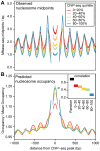Controls of nucleosome positioning in the human genome
- PMID: 23166509
- PMCID: PMC3499251
- DOI: 10.1371/journal.pgen.1003036
Controls of nucleosome positioning in the human genome
Abstract
Nucleosomes are important for gene regulation because their arrangement on the genome can control which proteins bind to DNA. Currently, few human nucleosomes are thought to be consistently positioned across cells; however, this has been difficult to assess due to the limited resolution of existing data. We performed paired-end sequencing of micrococcal nuclease-digested chromatin (MNase-seq) from seven lymphoblastoid cell lines and mapped over 3.6 billion MNase-seq fragments to the human genome to create the highest-resolution map of nucleosome occupancy to date in a human cell type. In contrast to previous results, we find that most nucleosomes have more consistent positioning than expected by chance and a substantial fraction (8.7%) of nucleosomes have moderate to strong positioning. In aggregate, nucleosome sequences have 10 bp periodic patterns in dinucleotide frequency and DNase I sensitivity; and, across cells, nucleosomes frequently have translational offsets that are multiples of 10 bp. We estimate that almost half of the genome contains regularly spaced arrays of nucleosomes, which are enriched in active chromatin domains. Single nucleotide polymorphisms that reduce DNase I sensitivity can disrupt the phasing of nucleosome arrays, which indicates that they often result from positioning against a barrier formed by other proteins. However, nucleosome arrays can also be created by DNA sequence alone. The most striking example is an array of over 400 nucleosomes on chromosome 12 that is created by tandem repetition of sequences with strong positioning properties. In summary, a large fraction of nucleosomes are consistently positioned--in some regions because they adopt favored sequence positions, and in other regions because they are forced into specific arrangements by chromatin remodeling or DNA binding proteins.
Conflict of interest statement
The authors have declared that no competing interests exist.
Figures






Similar articles
-
Subtracting the sequence bias from partially digested MNase-seq data reveals a general contribution of TFIIS to nucleosome positioning.Epigenetics Chromatin. 2017 Dec 7;10(1):58. doi: 10.1186/s13072-017-0165-x. Epigenetics Chromatin. 2017. PMID: 29212533 Free PMC article.
-
Principles of nucleosome organization revealed by single-cell micrococcal nuclease sequencing.Nature. 2018 Oct;562(7726):281-285. doi: 10.1038/s41586-018-0567-3. Epub 2018 Sep 26. Nature. 2018. PMID: 30258225 Free PMC article.
-
Chromatin structure of the yeast URA3 gene at high resolution provides insight into structure and positioning of nucleosomes in the chromosomal context.J Mol Biol. 1996 Apr 19;257(5):919-34. doi: 10.1006/jmbi.1996.0212. J Mol Biol. 1996. PMID: 8632475
-
Resolving nucleosomal positioning and occupancy with MNase-seq.Yi Chuan. 2020 Dec 17;42(12):1143-1155. doi: 10.16288/j.yczz.20-178. Yi Chuan. 2020. PMID: 33509779 Review.
-
Nucleosome positioning in yeasts: methods, maps, and mechanisms.Chromosoma. 2015 Jun;124(2):131-51. doi: 10.1007/s00412-014-0501-x. Epub 2014 Dec 23. Chromosoma. 2015. PMID: 25529773 Review.
Cited by
-
Functional characterization of open chromatin in bidirectional promoters of rice.Sci Rep. 2016 Aug 25;6:32088. doi: 10.1038/srep32088. Sci Rep. 2016. PMID: 27558448 Free PMC article.
-
MPE-seq, a new method for the genome-wide analysis of chromatin structure.Proc Natl Acad Sci U S A. 2015 Jul 7;112(27):E3457-65. doi: 10.1073/pnas.1424804112. Epub 2015 Jun 15. Proc Natl Acad Sci U S A. 2015. PMID: 26080409 Free PMC article.
-
Generating specificity in genome regulation through transcription factor sensitivity to chromatin.Nat Rev Genet. 2022 Dec;23(12):728-740. doi: 10.1038/s41576-022-00512-6. Epub 2022 Jul 12. Nat Rev Genet. 2022. PMID: 35831531 Review.
-
OCEAN-C: mapping hubs of open chromatin interactions across the genome reveals gene regulatory networks.Genome Biol. 2018 Apr 24;19(1):54. doi: 10.1186/s13059-018-1430-4. Genome Biol. 2018. PMID: 29690904 Free PMC article.
-
Nucleosome positioning sequence patterns as packing or regulatory.PLoS Comput Biol. 2020 Jan 27;16(1):e1007365. doi: 10.1371/journal.pcbi.1007365. eCollection 2020 Jan. PLoS Comput Biol. 2020. PMID: 31986131 Free PMC article.
References
-
- Kornberg RD (1974) Chromatin structure: a repeating unit of histones and DNA. Science 184: 868–871. - PubMed
-
- Kornberg RD, Lorch Y (1999) Twenty-five years of the nucleosome, fundamental particle of the eukaryote chromosome. Cell 98: 285–294. - PubMed
-
- Kaplan T, Li XY, Sabo PJ, Thomas S, Stamatoyannopoulos JA, et al. (2011) Quantitative Models of the Mechanisms That Control Genome-Wide Patterns of Transcription Factor Binding during Early Drosophila Development. PLoS Genet 7: e1001290 doi:10.1371/journal.pgen.1001290. - DOI - PMC - PubMed
-
- Albert I, Mavrich TN, Tomsho LP, Qi J, Zanton SJ, et al. (2007) Translational and rotational settings of H2A.Z nucleosomes across the Saccharomyces cerevisiae genome. Nature 446: 572–576. - PubMed
Publication types
MeSH terms
Substances
Associated data
- Actions
Grants and funding
LinkOut - more resources
Full Text Sources
Other Literature Sources
Molecular Biology Databases

